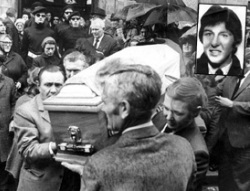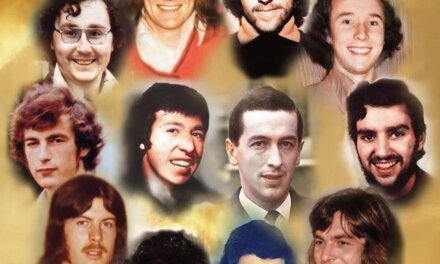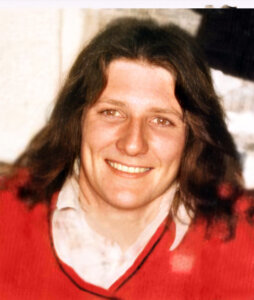June 3rd was the 35th anniversary of the death on hunger strike of Michael Gaughan from Ballina, County Mayo. Michael Gaughan, was the eldest of six children. After finishing his schooling, he left Ireland for England, in search of work. Whilst in England, he joined the IRA and became an active Volunteer in a London-based Active Service Unit. During a mission to gather funds for the IRA campaign, he was captured and ultimately convicted of arms possession and conspiracy to rob a London bank. Gaughan was sentenced to seven years imprisonment in the Old Bailey in December 1971.
His first two years of imprisonment were in Wormwood Scrubs in London. He was then moved to Albany Prison on the Isle of Wight where his request for political status was refused and he was punished with solitary confinement for even daring to claim it. He was later moved to Parkhurst Prison.
In November 1973, the trial of 10 Irish people for bomb explosions in London saw four begin a hunger-strike immediately for political status and repatriation. Their demands were simple: a guarantee that they would not be returned to solitary confinement; the right to educational facilities and not to do prison work; the setting of a reasonable date for a transfer to an Irish prison. Within days, the prison authorities began force-feeding Dolores and Marion Price, Hugh Feeney and Gerry Kelly. They were brutally force-fed for 206 days. On 31st March 1974, Frank Stagg, Paul Holmes, Hugh Feeney and Michael Gaughan joined the strike. Twenty-three days into his strike, Michael was force-fed for the first time. The method of force-feeding hadn’t changed from the days when Thomas Ashe died due to the brutality of it in 1917. The brutality of the force-feeding and resisting the doctors and the warders took its toll on the hunger-strikers. It left them battered and bruised, drained physically and mentally. The physiological torture of this barbaric assault on a person also had an effect as one of the hunger-strikers recounted to a relative at the time:
“The mental agony of waiting to be force-fed is getting to the stage where it now outweighs the physical discomfort of having to go through with it.”
During his hunger-strike Michael was force-fed 17 times, the last time on the evening of June 2.
The physical toll on the hunger-strikers is borne out by Gaughan’s brother John’s statement of his condition when he last saw him. His throat had been badly cut by force feeding and his teeth loosened. His eyes were sunken, his cheeks hollow and his mouth was gaping open. He weighed about six stone.
Visitors to the hunger strikers were only allowed to see them through a glass screen, supervised by prison warders. In what must have been a very emotional visit Gaughan’s mother Delia saw him alive for the last time through this screen three days before his death.
On 3rd June 1974, sixty-four days into his hunger strike, the prison authorities announced that Michael Gaughan had died. They later explained that he died from pneumonia, a result of the force-feeding tube having pierced his lung and food lodging in his lung. He was 24-years-old.
The manner of his death caused controversy in medical circles and the method of force-feeding was later abandoned by the British state.
Following Gaughan’s death, the remaining hunger strikers ended their fast after assurances from the prison authorities that they would be transferred to a prison in Ireland. The British, however, pursued a policy of seeming to concede to prisoners’ demands when they were on hunger strike only to renege once the prisoner came off protest.
From the Isle of Wight, Michael’s remains were brought to London. On 7th and 8th June, thousands lined the streets of Kilburn and marched behind the coffin, which was flanked by an IRA guard of honour.
On Saturday, 8th June, Gaughan’s remains reached Dublin where they were met by tens of thousands of mourners. Under another IRA guard of honour, Gaughan’s body was brought to the Adam and Eve’s Franciscan church on Merchant’s Quay, where thousands more filed past as it lay in state.
The following morning, Michael Gaughan began his final journey home. From Dublin to Ballina, his cortege was met by thousands paying their last respects in every town and village en route.
After Mass in Ballina Cathedral, the IRA paid its respects to a loyal soldier of Ireland, firing a volley above his coffin before it was taken to Leigue Cemetery to be buried in the Republican Plot.
In his last message to his republican comrades, Michael Gaughan had said:
“I die proudly for my country and in the hope that my death will be sufficient to obtain the demands of my comrades. Let there be no bitterness on my behalf but a determination to achieve the new Ireland for which I gladly die. My loyalty and confidence is to the IRA and let those of you who are left carry on the work and finish the fight.”




